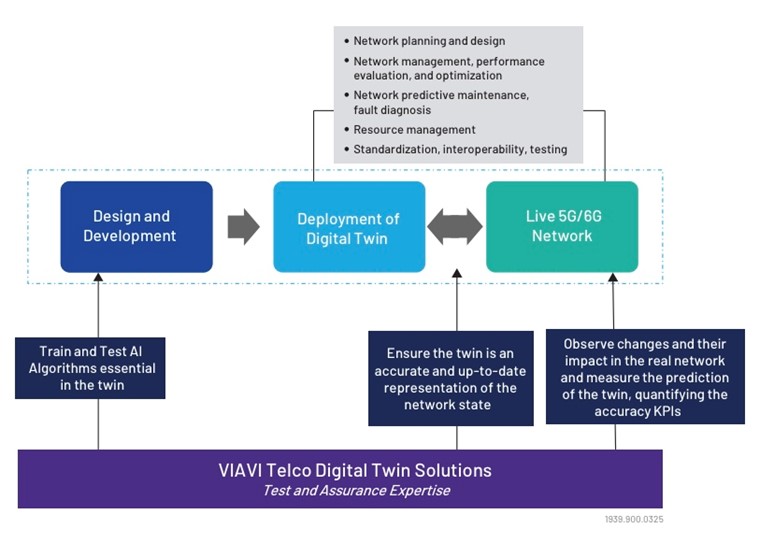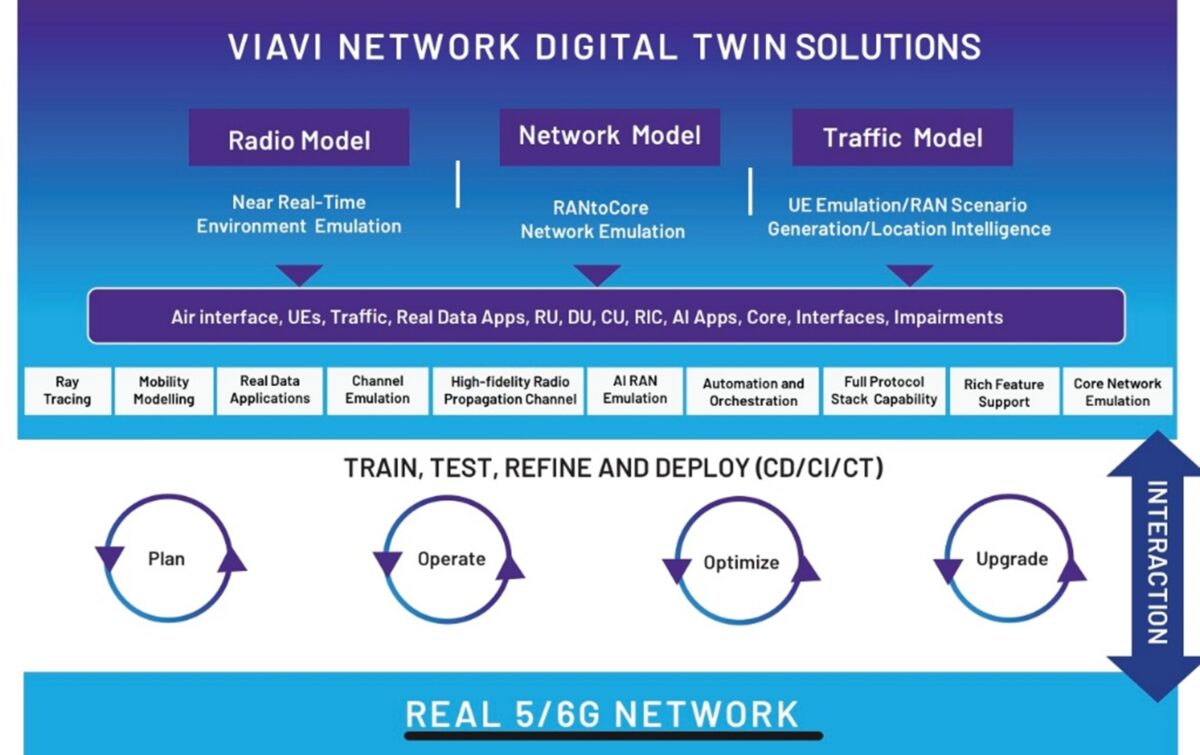The Role of Digital Twins in Advancing 6G Networks

Modeling telecom networks digitally in advance to building them out brings several advantages. Notably, it becomes possible to assess performance, study problems and evaluate potential solutions for the network before a single cable is connected or a single mast is built.
This means more reliable networks that can be created more quickly, scale faster and use newer technologies with less risk. What’s more, all of this can be achieved with a reduced total cost of ownership (TCO). This is particularly vital for both 5G and future 6G networks which will encompass both Open RAN components and Non-Terrestrial Network (NTN) satellite communication.
As a virtual copy of a live network, a digital twin is built to operate continuously and evolve over time by assimilating data from the real world. This can deliver value throughout the life of the live network and beyond. The two can grow together, with the digital twin acting as both an operational duplicate, giving real-time feedback and supporting activities such as network optimization and predictive maintenance, and a strategic sandbox for testing new configurations and strategies.
As we see in Figure 1, the digital twin is designed and developed carefully to be a close representation of the live network.

Figure 1. Designing, deploying, and maintaining a digital twin.
Taking this approach also enables the testing and validation of upgrades, alternative configurations and corrective actions, giving enhanced network performance and energy efficiency, as well as a better QoS, reliability and security, with maintenance planned as needed to avoid emergency repairs and downtime.
The digital twin can run continuously, receiving real-time data such as latency, throughput, fault logs, and customer experience metrics, and enabling the analysis of traffic flow, identification of bottlenecks, and the creation of a sandbox environment for testing. For example, such an approach could verify the resilience of a network to DDoS attacks.
Building the Digital Twin
There are multiple ways to implement a digital twin and personalize or tailor the engine to meet specific needs. A network replica could be built based solely on in-house skills and resources, or a partner could be worked with using field-proven platforms. Either way, a combination of instruments is needed for validating the digital twin and establishing experimental scenarios to capture results with which to direct actions in the real network. This includes instruments for gathering real measurements from the network as well as instruments for applying conditions to the digital twin and measuring responses.

Figure 2. Digital twin tools permit modelling selected aspects such as the RAN or core, or the entire network.
Regardless of whether the digital twin is designed to replicate individual aspects of the network or a complete RAN-to-Core implementation (figure 2), it is vital to test the accuracy of the twin by comparing predictions with results seen in the live network and maintain synchronisation after deployment to ensure the twin remains up to date.
Creating and operating a digital twin calls for some or all of the following:
- User equipment (UE) emulation
- A RAN scenario generator (RSG)
- Ray tracing capability
- Core emulator
- Orchestration engine
- Validation engine
- Security test cases
- Live data-capture tools
- Wireless field instruments
Advanced Networks
As new sites, cells, and edge nodes come online, the digital twin ingests their topology, configuration, and telemetry to expand its scope. The twin can simulate coverage, capacity, and interference for various rollout phases. Moreover, amid shifting regulatory conditions such as spectrum allocation and EMF exposure limits, the twin can help ensure compliant deployment.
As we move towards 6G, network operators can take advantage of digital twins that already mirror the 5G network. And as 6G introduces new paradigms such as native AI and integrated sensing and communication (ISAC), the twin can evolve to also model these without starting from scratch.
FR3 radio spectrum will be the natural area of expansion in 6G for both coverage and capacity, and evaluating how it can be used in conjunction with FR1 radio to achieve coverage and performance goals for the network is crucial. To conduct such an evaluation, ray tracing can be used to simulate how wireless signals interact with features such as walls or other obstacles, and then combined with RAN scenario generation to provide scale by simulating multiple radios with similar characteristics. UE emulation can provide FR1 and FR3 simulations and the digital twin helps inject anomalies and plan various scenarios depending on thousands of variables. Using these tools, engineers can design, analyse, and optimize communication systems to ensure better performance and coverage in different environments.
Digital twins can help incorporate new capabilities in 6G base stations and radios such as ISAC, which could provide high-accuracy localization, gesture recognition, and environmental mapping. They can help ensure ISAC algorithms will work as expected by providing near real-time ray tracing for the ISAC RF environment coupled with channel modelling to emulate targets such as drones, cars, and pedestrians, as well as incorporating sensing receiver emulation.
Use Cases
Digital twins are already at work preparing the way for 6G in several projects by leading research teams worldwide:
US 6G City-Scale Digital Twin project
The 6G city-scale digital twin at Northeastern University is powered by advanced AI and machine learning (ML) technologies for training components like the 6G AI-Native Air Interface and understanding network dynamics and performance. This achievement underscores the importance of AI/ML in radio propagation modelling for large-scale network digital twins, integrating insights from real-world measurements and higher-layer KPIs through cooperative efforts.
UK TUDOR project
The TUDOR project involves a consortium of UK universities and international operators and vendors, including VIAVI. It aims to tackle big challenges such as the digital divide and energy efficiency through research and innovation in open network components. Hosted by 5G/6G Innovation Centre at the University of Surrey, the project explores and expands on Open RAN principles, focusing on new open network components and their technical capabilities, as well as interoperability in the wider RAN and core. The initiative is uncovering new testing challenges and opportunities in 6G networks. VIAVI is supporting the project with expertise and resources for modelling and testing, including 6G 3D channel modelling and a 3D RAN digital twin.
EU 6G-TWIN
The European 6G-TWIN project is laying the foundation for digital twins to empower operational networks, focusing on reactive and predictive network digital twins to enable tele-operated driving and energy-saving use cases. The project proposes an AI-native reference architecture for 6G systems that incorporates network digital twins as a core mechanism for the end-to-end, real-time optimization, management, and control of highly dynamic and complex network scenarios.
The project will deliver methods, modeling, and simulation solutions to define, create, and manage multi-layered virtual representations of future 6G systems that comprise various domains such as edge, fog, and cloud with communication technologies including cellular, optical, and Non-Terrestrial Networks (NTN).
UK Open Networks Ecosystem
The ARIANE (Accelerating RAN Intelligence Across Network Ecosystems) project will simulate a real-world multi-vendor Open RAN small-cell environment with multiple RAN intelligent controllers (RICs) and xApps/rApps. The project will analyze and recommend opportunities for security hardening, measure the impact on RAN performance in various test scenarios with multiple xApps and rApps, and provide insights for standards development within the O-RAN Alliance. Digital twin with multiple RICs will test xApps and rApps for energy management, traffic steering, advanced traffic steering, and QoS-based dynamic resource allocation.
Singapore O-RAN ALLIANCE Global Plugfest
The Singapore University of Technology and Design (SUTD) worked with VIAVI on an advanced digital twin solution to enhance energy savings in Open RAN-based 5G networks. The team developed a synchronisation rApp that keeps the digital twin synchronised with the actual network in real-time. Using an AI RAN Scenario Generator (AI RSG), the digital twin helped train and test the AI models for energy-saving strategies in a safe environment. These strategies were then validated in a smaller real-world setup, proving that the energy-saving decisions could be readily applied to actual networks. Because the solution follows O-RAN’s open interface standards, it is highly scalable and can easily integrate with other systems.
Conclusion
Digital twins are widely used for efficient and low-risk design, testing, and long-term management and evolution, adopted by network operators and equipment manufacturers. With proven tools available for emulating and testing specific aspects, such as the RAN, core, or the entire network, accurate digital twins have assisted 5G rollout and are now ready to evolve in step with existing networks to accelerate the transition to 6G.



